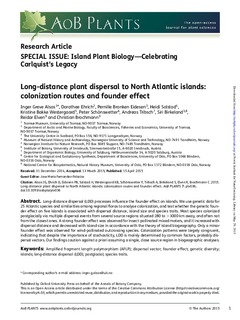Long-distance plant dispersal to North Atlantic islands:colonization routes and founder effect
| dc.contributor.author | Alsos, Inger Greve | |
| dc.contributor.author | Ehrich, Dorothee | |
| dc.contributor.author | Eidesen, Pernille Bronken | |
| dc.contributor.author | Solstad, Heidi Merethe | |
| dc.contributor.author | Westergaard, Kristine Bakke | |
| dc.contributor.author | Schonswetter, Peter | |
| dc.contributor.author | Tribsch, Andreas | |
| dc.contributor.author | Birkeland, Siri | |
| dc.contributor.author | Elven, Reidar | |
| dc.contributor.author | Brochmann, Christian | |
| dc.date.accessioned | 2015-05-29T08:37:33Z | |
| dc.date.accessioned | 2015-07-07T08:58:55Z | |
| dc.date.available | 2015-05-29T08:37:33Z | |
| dc.date.available | 2015-07-07T08:58:55Z | |
| dc.date.issued | 2015 | |
| dc.identifier.citation | AoB Plants 2015, 1 | nb_NO |
| dc.identifier.issn | 2041-2851 | |
| dc.identifier.uri | http://hdl.handle.net/11250/286630 | |
| dc.description | - Published article - CC BY 4.0 | nb_NO |
| dc.description.abstract | Long-distance dispersal (LDD) processes influence the founder effect on islands.We use genetic data for 25 Atlantic species and similarities among regional floras to analyse colonization, and test whether the genetic founder effect on five islands is associated with dispersal distance, island size and species traits. Most species colonized postglacially via multiple dispersal events from several source regions situated 280 to .3000 km away, and often not from the closest ones. A strong founder effect was observed for insect-pollinated mixed maters, and it increased with dispersal distance and decreased with island size in accordance with the theory of island biogeography. Only a minor founder effect was observed for wind-pollinated outcrossing species. Colonization patterns were largely congruent, indicating that despite the importance of stochasticity, LDD is mainly determined by common factors, probably dispersal vectors. Our findings caution against a priori assuming a single, close source region in biogeographic analyses. Amplified fragment length polymorphism (AFLP); dispersal vector; founder effect; genetic diversity; islands; long-distance dispersal (LDD); postglacial; species traits. | nb_NO |
| dc.language.iso | eng | nb_NO |
| dc.publisher | Oxford University Press | nb_NO |
| dc.rights | Attribution 4.0 International (CC BY 4.0) You are free to: Share — copy and redistribute the material in any medium or format Adapt — remix, transform, and build upon the material for any purpose, even commercially. The licensor cannot revoke these freedoms as long as you follow the license terms | |
| dc.rights.uri | http://creativecommons.org/licenses/by/4.0/ | |
| dc.title | Long-distance plant dispersal to North Atlantic islands:colonization routes and founder effect | nb_NO |
| dc.type | Journal article | nb_NO |
| dc.type | Peer reviewed | en_GB |
| dc.date.updated | 2015-05-29T08:37:33Z | |
| dc.source.pagenumber | plv036 | nb_NO |
| dc.source.volume | 7 | nb_NO |
| dc.source.journal | AoB Plants | nb_NO |
| dc.source.issue | Special Issue | nb_NO |
| dc.identifier.doi | 10.1093/aobpla/plv036 | |
| dc.identifier.cristin | 1245070 |
Tilhørende fil(er)
Denne innførselen finnes i følgende samling(er)
-
Institutt for naturhistorie [1241]
-
Publikasjoner fra CRIStin - NTNU [38484]
Med mindre annet er angitt, så er denne innførselen lisensiert som Attribution 4.0 International (CC BY 4.0)
You are free to:
Share — copy and redistribute the material in any medium or format
Adapt — remix, transform, and build upon the material
for any purpose, even commercially.
The licensor cannot revoke these freedoms as long as you follow the license terms

